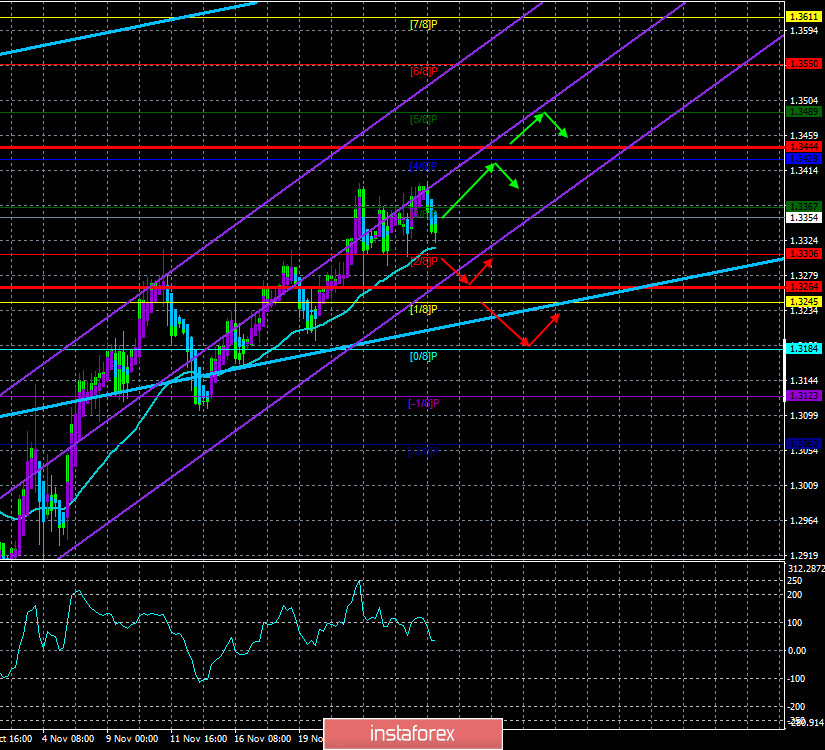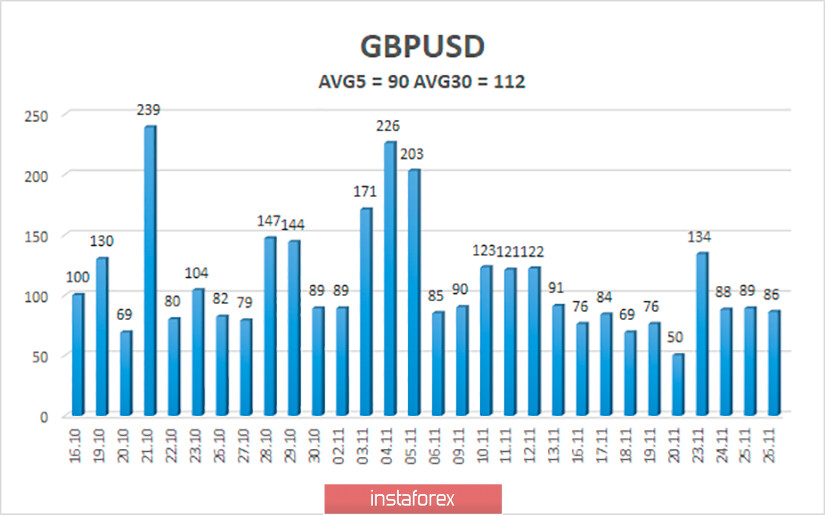4-hour timeframe

Technical details:
Higher linear regression channel: direction - upward.
Lower linear regression channel: direction - upward.
Moving average (20; smoothed) - upward.
CCI: 41.9598
The British pound began to adjust on Thursday as part of an upward trend. We do not believe that the pound's pullback from its local highs is due to some market disappointment with how the Brexit negotiations are progressing. We have repeatedly stated that the pound should now rush on all pairs to the level of 1.20 since there is no basis for a statement about the possible conclusion of a trade agreement between the UK and the EU. Moreover, every day, traders get information that most likely there will be no deals in the near future, and the parties are openly bluffing and dissembling, making statements to the public. How do you feel about the words of Boris Johnson now, if earlier he stated that "it is better to die in a ditch than ask the EU to postpone Brexit"? Or when Boris Johnson said that the negotiations would last until October 15 (and then November 15), after which London will withdraw from the discussion of the trade deal, and now it is November 27 and the negotiations continue? Boris Johnson's friend, US President Donald Trump, can be said to have already paid the price for daily misleading statements. How can you trust the President if his country's statistical agencies count how many times a day their national leader lies? Now we see that Boris Johnson is confidently following the path of Donald Trump. Throughout 2020, the British Prime Minister said that the "transition period" would not be extended, that negotiations would end immediately if London realized that Brussels would not give it the deal it wanted. So what? Negotiations are continuing, although the end of the "transition period" is just over a month away. Formally, the parties do not have time, since any agreement needs to be ratified, it must be considered by both Parliaments, and in December there will be more Christmas and New Year holidays. It seems that we were right when we said that the negotiations will continue for as long as it takes. They will likely continue in 2021.
In the next article, we looked at what losses await the European economy from the second "lockdown". By the end of 2020, as Christine Lagarde said, the Eurozone's GDP could lose from 8 to 12%. And this forecast is unlikely to enter the second "lockdown". However, in any case, the UK will lose more, as evidenced by statistics for the second quarter. In Britain, a second "lockdown" was also introduced, which means there will be losses in the fourth quarter of 2020. Most recently, Bank of England Governor Andrew Bailey said that the losses to the economy from the lack of a trade deal with the EU would be disproportionately higher than the negative impact of the pandemic. By simple logic and comparison of figures, we can assume that the British economy will lose more than 12% in 2020 and continue to shrink in 2021. Thus, there is no question of any bright future for Britain right now. The Kingdom's business is already begging the government to make a deal with the EU at any cost. Treasury Chief Rishi Sunak urges not to make a deal "at any cost." There is a serious political game going on, where every word can affect the outcome. And at the same time, the pound sterling as a whole continues to rise in price. What is it? Blind faith of market participants that the deal will take place anyway, sooner or later? Well, if the parties continue to negotiate for another six months, will the pound continue to grow? This is the illogical behavior of the British currency.
Meanwhile, the British-European negotiations themselves may once again reach an impasse. For the past month, Michel Barnier and David Frost have been working on the agreement seven days a week, but as it turned out this week, all outstanding issues remain and there is no particular progress in them. Even though some media reported that the deal was 95% agreed upon, the head of the European Commission, Ursula von der Leyen, believes that there are very serious differences between the parties on key issues. Michel Barnier is once again threatening to pull out of the talks and not even fly to Brussels on Saturday to hold a face-to-face meeting with David Frost if London does not start to concede. French Foreign Minister Jean-Yves Le Drian accuses the British of deliberately delaying negotiations and says that Paris will not give in to the issue of fishing in British waters. Thus, we would say that the probability of signing an agreement is 5 percent rather than 95 percent. We have already said that the parties can agree on 95% of all issues, but if they do not reach a consensus on the most important ones, then there will be no deal.
As a result, the conclusions remain the same as they were a month ago and three months ago. The probability of concluding a trade agreement remains very low, and there is no official information about whether the parties are moving towards each other on the most important issues. It is one thing if the differences remain, but with each new meeting, they become less and less, another – if their number does not decrease. But neither Barnier nor Frost shares this information with traders. Thus, we still believe that if a deal is made, it will not be in the near future. And the pound will almost certainly fall sooner or later. The only question is when market participants will stop believing that London and Brussels will work a miracle. Recall that almost from the very moment Boris Johnson came to power, he was talking about a "hard" Brexit. In other words, we can assume that London was set up for a hard "divorce" from the very beginning. If this is a bluff, then the British Prime Minister did not manage to get any particularly large dividends out of it. Whatever the intentions of the British government, the British economy and the British pound will in any case be under pressure in the next six months.

The average volatility of the GBP/USD pair is currently 90 points per day. For the pound/dollar pair, this value is "average". On Friday, November 27, thus, we expect movement inside the channel, limited by the levels of 1.3264 and 1.3444. A reversal of the Heiken Ashi indicator to the top signals the resumption of the upward movement.
Nearest support levels:
S1 – 1.3306
S2 – 1.3245
S3 – 1.3184
Nearest resistance levels:
R1 – 1.3367
R2 – 1.3428
R3 – 1.3489
Trading recommendations:
The GBP/USD pair has started a new round of corrective movement on the 4-hour timeframe. Thus, today it is recommended to open new long positions with targets of 1.3428 and 1.3444 after a new reversal of the Heiken Ashi indicator up. It is recommended to trade the pair down with targets of 1.3264 and 1.3245 if the price is fixed below the moving average line.
 English
English 
 Русский
Русский Bahasa Indonesia
Bahasa Indonesia Bahasa Malay
Bahasa Malay ไทย
ไทย Español
Español Deutsch
Deutsch Български
Български Français
Français Tiếng Việt
Tiếng Việt 中文
中文 বাংলা
বাংলা हिन्दी
हिन्दी Čeština
Čeština Українська
Українська Română
Română

